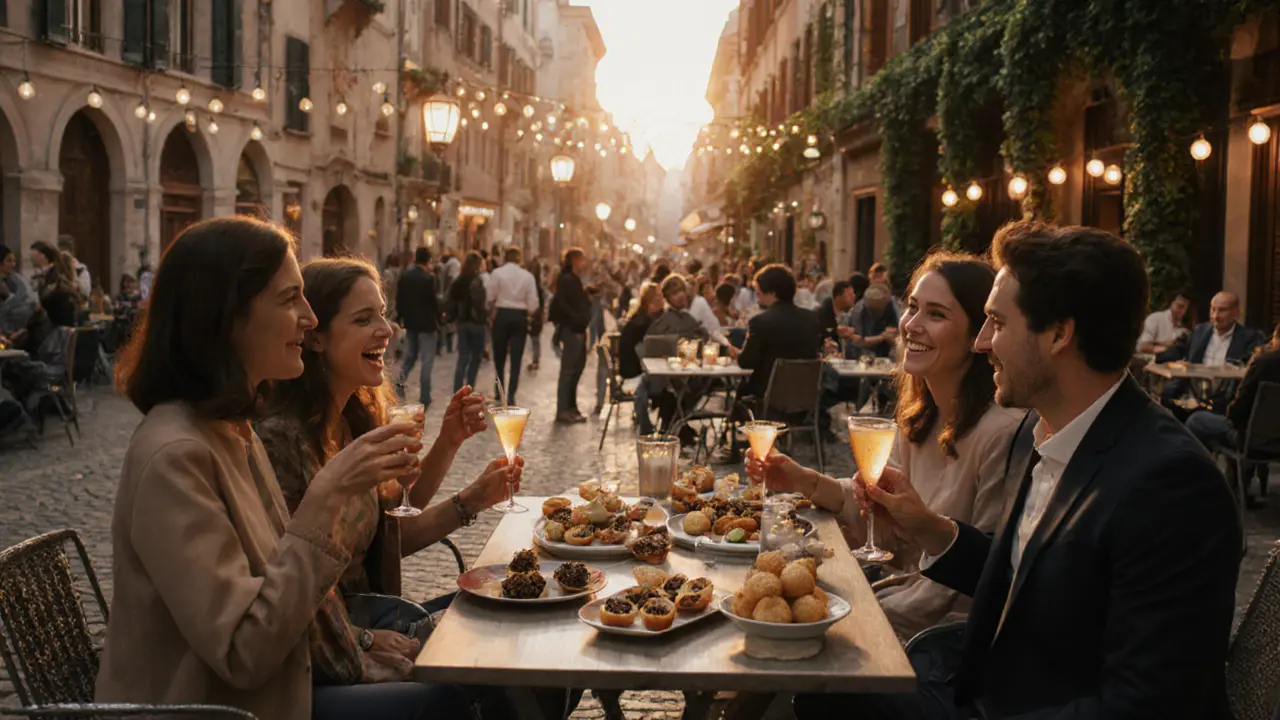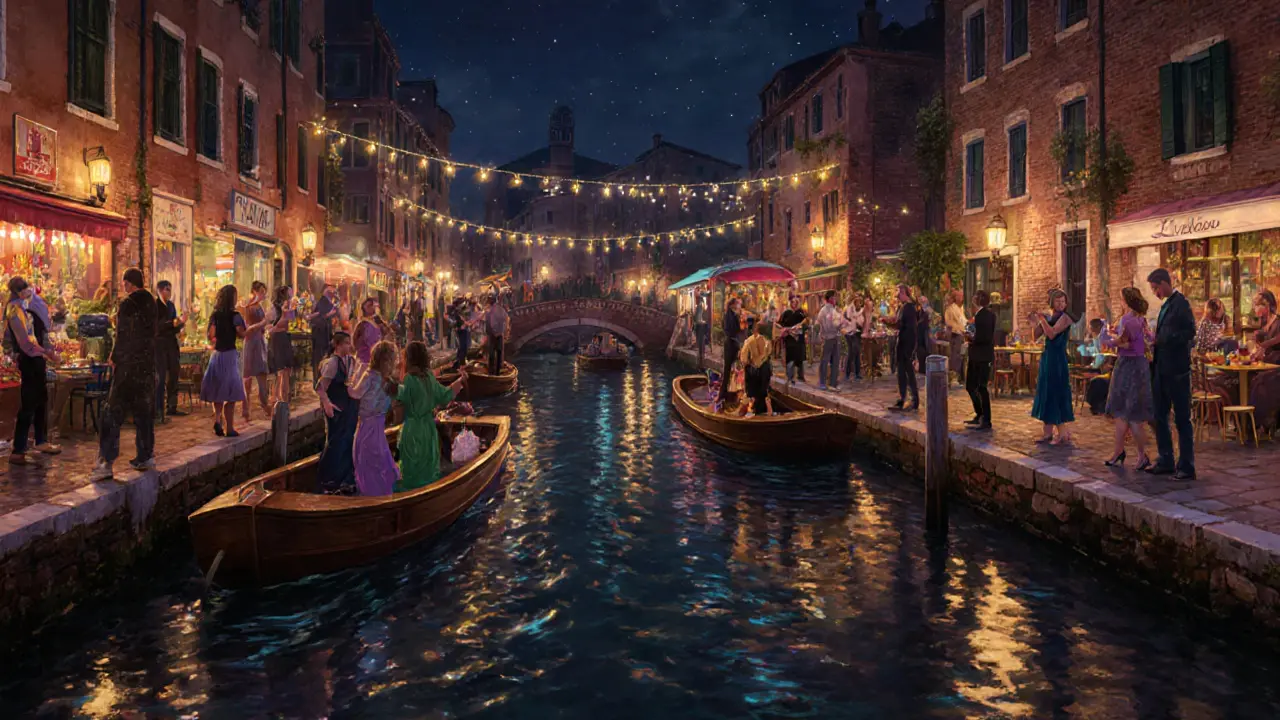The Best Nightlife in Milan: Where to Party Like a Local
 Oct, 29 2025
Oct, 29 2025
When the sun sets in Milan, the city doesn’t sleep - it switches modes.
Forget what you’ve heard about Milan being all about fashion shows and quiet espresso bars. By 10 p.m., the streets of Brera, Navigli, and Porta Venezia come alive with music, laughter, and clinking glasses. This isn’t just partying - it’s a cultural ritual. Locals don’t rush into clubs. They start with an aperitivo, move to a jazz bar, then hit a hidden nightclub before dawn. If you want to experience Milan after dark the right way, here’s exactly where to go.
Start with the Aperitivo: Milan’s Secret Social Ritual
The night in Milan doesn’t begin with a shot. It begins with an aperitivo. Between 7 and 9 p.m., bars across the city offer free or low-cost snacks with every drink. You pay €12-€18 for a cocktail or glass of prosecco, and you get access to a buffet that could pass for a dinner. Think gourmet arancini, truffle crostini, smoked salmon rolls, and even pasta salads. It’s not a gimmick - it’s tradition.
Head to Terrazza Aperol in the Brera district. It’s not the cheapest, but it’s the most authentic. The terrace overlooks quiet cobblestone streets, and the crowd is a mix of designers, artists, and students. Or try Bar Basso in the city center - the birthplace of the Negroni Sbagliato. Order one. Sit at the bar. Watch the bartender work like a poet.
Navigli: Where the River Becomes a Dance Floor
If you want to see Milan’s soul, go to Navigli. This canal-side neighborhood used to be a working port. Now, it’s the city’s most vibrant open-air party zone. On Friday and Saturday nights, the sidewalks turn into a street festival. Music spills from open doors. People dance on boats. You’ll find everything from reggae DJs to electronic sets under string lights.
Start at La Scala Navigli, a converted warehouse with a rooftop terrace and a crowd that stays until 3 a.m. Then walk 10 minutes to Bar Basso Navigli - yes, the same crew behind the original - where the drinks are cheaper and the vibe is looser. Don’t miss La Baita, a tiny bar with a secret backroom that only opens after midnight. Ask for the password: "La notte è nostra."
Clubbing Like a Pro: Milan’s Top 3 Nightclubs
Milan’s club scene is split between underground spots and world-famous venues. If you’re looking for international DJs, big production, and velvet ropes, here are the three that matter most in 2025.
- La Scala Club - Not to be confused with the opera house. This is a 2,000-capacity club in the Porta Venezia area. It hosts names like Charlotte de Witte and Amelie Lens. Entry is €25-€40 on weekends. Dress code: smart casual. No sneakers. No hoodies.
- Opium - Hidden in a former cinema near the Duomo, Opium is where Milan’s elite go after the main clubs close. It’s small, intimate, and only opens after 1 a.m. The music is deep house and techno. No list. No pretense. Just good sound and a crowd that knows how to move.
- Teatro del Silenzio - A warehouse-turned-club in the outskirts, accessible only by metro (Line 2 to Romolo). This is the place for experimental sounds, live visuals, and all-night sets. No name on the door. No bouncers. You’ll know you’re in the right place when you hear the bass drop through the concrete walls.

Hidden Gems: Where Locals Go When Tourists Leave
If you’ve already hit the big names, it’s time to find the real ones. Milan has dozens of underground spots that don’t show up on Google Maps. These aren’t secret - they’re just not marketed.
- Il Gatto Nero - A speakeasy-style bar in the heart of Porta Ticinese. You’ll find it behind a fridge door. No sign. Just a single red light. Inside: vintage cocktails, vinyl records, and a jazz trio that plays only on Thursdays.
- Bar del Fico - A tiny wine bar in the Lambrate district. They serve natural wines from small Italian vineyards. No cocktails. No neon. Just 20 bottles, a few stools, and a guy who’ll tell you about the soil where the grapes grew.
- Spazio 18 - A collective space in the former factory district. On weekends, it turns into a hybrid art gallery and party. Local DJs, live painting, and free vegan snacks. No cover charge. Bring cash. It closes at 5 a.m.
What to Wear: Milan’s Unwritten Dress Code
Milan doesn’t care if you’re rich. It cares if you look like you tried.
For aperitivo: Clean jeans, a button-down shirt, loafers. No tank tops. No flip-flops.
For clubs: Slim-fit trousers or tailored shorts. A fitted jacket or blazer. Even if it’s hot. Milanese nightlife is a fashion show - and you’re part of the cast. Men, skip the baseball caps. Women, skip the oversized dresses. Think minimalist chic, not clubwear.
And never, ever wear sneakers to a club like La Scala. You’ll be turned away.
When to Go: Timing Is Everything
Don’t show up at 10 p.m. expecting to dance. Milan doesn’t move until after midnight.
- 7-9 p.m.: Aperitivo time. Start here.
- 10-11 p.m.: Bar hopping. Move from one spot to the next. Don’t stay too long.
- 12-2 a.m.: Clubs open. This is when the real crowd arrives.
- 3-5 a.m.: The afterparties. Opium, Spazio 18, and Teatro del Silenzio are just waking up.
Most clubs don’t get busy until 1 a.m. If you’re leaving by 2 a.m., you missed the best part.

How to Get Around: Skip the Taxi
Taxis in Milan are expensive and slow. The metro runs until 1:30 a.m. on weekdays and 2:30 a.m. on weekends. Buy a 24-hour ticket for €7.50 - it covers metro, trams, and buses.
For Navigli, walk. It’s flat, safe, and the streets are lit. For Teatro del Silenzio, take the metro to Romolo. For La Scala, get off at Porta Venezia. Most spots are within 15 minutes of each other by public transit.
What Not to Do
Milanese nightlife is welcoming - but not tolerant of bad behavior.
- Don’t yell. People speak quietly, even when drunk.
- Don’t ask for vodka shots. No one drinks that here.
- Don’t take photos of strangers. It’s rude.
- Don’t show up without ID. You’ll be asked. No exceptions.
- Don’t try to haggle over prices. The aperitivo buffet is included. That’s it.
If you follow these rules, you’ll blend in. And that’s the highest compliment you can get in Milan.
Is Milan nightlife safe for tourists?
Yes, but only if you stay aware. The main nightlife districts - Brera, Navigli, Porta Venezia - are well-lit and patrolled. Avoid side streets after 2 a.m. and never walk alone through industrial areas like Lambrate after midnight. Pickpockets are rare, but bags should be kept close. Most clubs have security, and locals will help if you look lost.
Do I need to book tickets in advance?
For La Scala Club and other major venues, yes - especially on weekends. Use the official websites or apps like Resident Advisor. Smaller bars and hidden spots like Il Gatto Nero or Spazio 18 don’t require reservations. Walk-ins are welcome. If a place says "no cover," it means they don’t take bookings.
What’s the average cost for a night out in Milan?
Plan for €40-€80 total. That includes one aperitivo (€15), one club entry (€20-€30), and two drinks inside. If you stick to bars and skip the big clubs, you can do it for €25. Aperitivo buffets are the best value - you’re paying for food as much as drinks. Skip the tourist traps near the Duomo - they charge double for the same cocktail.
Are there any gay-friendly nightlife spots in Milan?
Yes. Milan is one of Europe’s most LGBTQ+-friendly cities. Bar 44 in the Brera district is a long-standing gay bar with drag shows on Fridays. Le Chat Noir in Porta Venezia is a queer-owned club with themed nights and live performances. La Vela is a rooftop bar with a mixed crowd and no dress code. All three are welcoming to allies.
What’s the best night of the week to go out in Milan?
Friday and Saturday are the busiest, but Wednesday and Thursday are the most fun. That’s when locals go out without the tourist crowd. Clubs like Opium and Teatro del Silenzio often have their best DJs on Thursdays. Navigli is quieter, but the bars are more relaxed. If you want real Milanese energy - not just noise - go midweek.
Final Tip: Don’t Rush It
Milan’s nightlife isn’t about checking boxes. It’s about lingering. Sip your drink slowly. Talk to the bartender. Let the music find you. The best nights don’t start with a plan - they start with a feeling. Walk without a destination. Let the sound of a saxophone pull you into a basement. Let the smell of grilled bread lead you to a hidden courtyard. That’s how locals do it. And that’s how you’ll remember Milan long after the last cocktail is gone.
